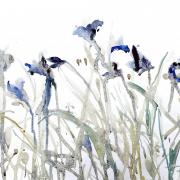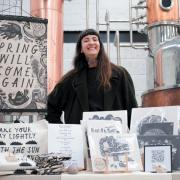For her latest novel Tracy Chevalier has taken inspiration from the embroideries found in Winchester Cathedral
Quilting, weaving, painting and tapestry. It takes a truly talented storyteller to imagine the stories behind crafts such as these and bring them to life.
Twenty years on from the publication of her first novel, Girl with a Pearl Earring, internationally bestselling author Tracy Chevalier continues to cast a spell over seemingly forgotten artistry from the past. Set in Winchester in 1932, her tenth and latest novel A Single Thread tells of the quintessentially English matters of embroidery and bellringing and the various communities which are the lifeblood of a cathedral.
The novel follows Violet Speedwell, an unmarried 'surplus' woman as she finds her feet following the deaths of her fiancé and brother in World War I. Striking out on her own, she moves to Winchester and wanders into the cathedral and the world of the broderers, a group of women charged with embroidering its kneelers. There she finds there is as much to learn about sewing and their intricate designs as there is about herself, while the present is overshadowed by the past and war looms once more on the horizon.
The first spark of inspiration for writing the book came from a lifelong love of cathedrals and a fascination for shining light on the rich stories these buildings have to tell as Tracy shares.
"I have long loved cathedrals: they are so grand and out of scale and are places that have had a lot of resources of time and money poured into them. Even in this secular age they are special places. I felt I wanted to set a novel in one."
It was Winchester Cathedral, with its hidden treasures from 16th century graffiti in the bellringing tower, exquisite carvings in the Fisherman's Chapel and chantries to the patterns and designs on kneelers, which caught her eye.
"Winchester has a lot of great stories attached to it - Jane Austen, the English Civil War, the diver William Walker shoring up the foundations in the early 20th century - but when I visited I was most attracted to the cushions and kneelers that were made by a group of volunteer women in the 1930s. I started thinking about what that broderers' group would have been like - the feuds and petty politics involved, and also what it would have felt like to contribute something, to make your mark on a cathedral by making something that will last hundreds of years."
Researching and writing the book took two years and in that time Tracy painstakingly visited the cathedral, talked to locals who grew up in the city during the period, and immersed herself in the craft of needlepoint itself, keen to do the historical facts justice as she drew together the threads of the novel. She and her husband even walked the Clarendon Way between Winchester and Salisbury Cathedrals as Violet does in the novel and Tracy tried her hand at bellringing. However, one of the joys of her meticulous research was the discovery of real-life embroiderer and designer, Louisa Pesel who was appointed Mistress of the Broderers in 1938.
"I found her really interesting - an independent woman who knew a lot about embroidery and found her own principled way in life. I decided she wouldn't be the main character - I tend to mix real people with fictional characters, and the real people are limited by their biographies. So Louisa Pesel has a smaller role, but it's very important as she is the moral compass of the book."
Writing about the interwar period allowed Tracy to explore the ideas, expectations and roles of women of the time, with the steadfastness and dogged determination of Louisa Pesel's character leading the way for Violet and the other broderers to make their own mark. First and foremost, this is a story of women forging their own identities as they challenge society and its perception of single women in the 1930s. Each individual thread coming together to create a new pattern.
"It's finding that balance between making your mark as an individual and finding your place as a member of society," Tracy explains. "I think that sometimes we veer too much one way or the other. It's important to be able to balance the two."
It's this commitment to accuracy and research which remains key to the process of writing for Tracy, with the act of committing pen to paper she describes as a magic trick.
"Writing is really hard. Even ten books on," she laughs. "Each day when I am in the writing phase, I have to really pull it out of myself. Some days are easier than others. The research is always a joy. It's kind of a necessary evil, the writing. I never want it to feel laboured. Ideally what I want is for the reader to feel as if I am just a page ahead of them, scribbling away and the ink is fresh. That feeling of spontaneity but also continuity."
Despite the whirlwind success of Girl with a Pearl Earring and subsequent hit novels, the fact that her writing is cherished some 20 years on, still surprises her.
"When you're writing something, you're immersed in it and it's very hard to think of it having a long-term legacy," she says. "I'm in a very lucky position because Girl with a Pearl Earring has allowed me to continue to write and write what I want and people pay attention to it and notice when something new is coming out."
Perhaps her popularity is testament to one of Tracy's greatest skills as a writer of historical fiction, being able to encourage the reader to reflect on how the future is born of the past and present. It would be easy to simply turn history into a pastiche of itself, yet there's a sense of constancy, tradition and timelessness in her novels, that somehow the marks we make continue to retell stories of identity but also shape the tales to follow.
"It's a reminder that not everything is centuries old. Some of it is only eight years old or whatever. Marks will continue to be made for hundreds of years. We have to represent who we are now and know that that too will blend into the fabric of the building," Tracy says. "I hope that people look at those cushions and kneelers in a new light or when they hear bells ringing from a church tower, they'll actually stop and listen."
The singlemindedness of Louisa Pesel, the singleness of Violet, the importance of each individual and the threads within a design, a solitary bell to mark the past, are all sewn together with Tracy's unique style to create a rich fictional world. Much like the kneelers and craftmanship of the broderers she transforms with her storytelling, something tells me that A Single Thread is set to offer the same delight and inspiration for many years to come.
More…
- What celebrities love most about Hampshire - Some of Hampshire's best known personalities have revealed what they most love about the county. Here, we compile some quotes from our interviews over the years



























